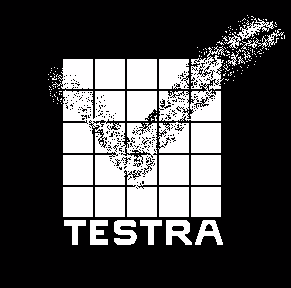 SS4544 SyncroStep Motion Control System
SS4544 SyncroStep Motion Control System
ssROUTER Control Panel SPECIFICATIONS
Testra Corporation 1201 N. Stadem Drive Tempe, AZ 85281 Ph:(480)560-6141
Fax:(480)907-2876
GO TO HOME PAGE
Update 2/3/9
INTRODUCTION
 The ssROUTER control panel operates on a RS-485 network with the ssROUTER
application which is running from flash memory in the ss4544 motion
control system. It is available in either a panel mount version
for small machines, or a handheld version for larger machines. Either panel
is connected to the ss4544 via an RJ-11 4 wire cable from which the power
and communication is supplied from the ss4544 motion control system.
At boot up when power is applied, the panel will first display a greeting
message for a few seconds. This message will then be replaced with the
Operation
Display . The physical display on the panel is a backlit LCD with four
lines of 20 characters each. There is an onboard digital temperature
sensor which is used to temperature compensate the LCD for automatic contrast
control. There are two LED indicators for job status indication on
both panels, with additional indicators on the hand held panel..
There is also a beeper on the panel for audio signaling. Eleven keys
are available for control, along with an encoder knob which may be
used for various adjustments. The panel mount version has a connector
that provides high current control outputs that may directly drive
mechanical or solid state relays for control of EXHAUST,
COOLANT, and VACUUM hold-down functions. A second connector
provided for an emergency stop button.
The ssROUTER control panel operates on a RS-485 network with the ssROUTER
application which is running from flash memory in the ss4544 motion
control system. It is available in either a panel mount version
for small machines, or a handheld version for larger machines. Either panel
is connected to the ss4544 via an RJ-11 4 wire cable from which the power
and communication is supplied from the ss4544 motion control system.
At boot up when power is applied, the panel will first display a greeting
message for a few seconds. This message will then be replaced with the
Operation
Display . The physical display on the panel is a backlit LCD with four
lines of 20 characters each. There is an onboard digital temperature
sensor which is used to temperature compensate the LCD for automatic contrast
control. There are two LED indicators for job status indication on
both panels, with additional indicators on the hand held panel..
There is also a beeper on the panel for audio signaling. Eleven keys
are available for control, along with an encoder knob which may be
used for various adjustments. The panel mount version has a connector
that provides high current control outputs that may directly drive
mechanical or solid state relays for control of EXHAUST,
COOLANT, and VACUUM hold-down functions. A second connector
provided for an emergency stop button.
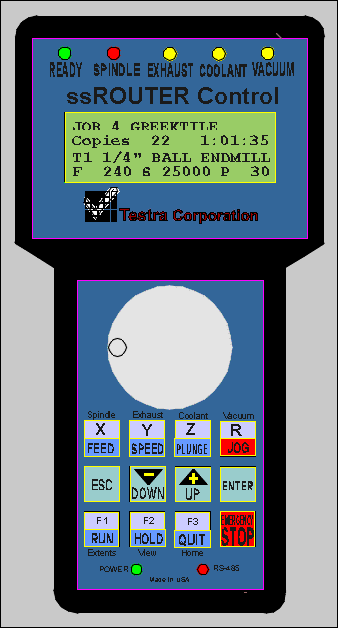
The Handheld control panel has additional yellow
indicators for the EXHAUST, COOLANT
and VACUUM functions. Access to these control
functions is via an optional machine automation I/O interface card.
The indicators on the panel will mirror the state of the outputs on the
I/O card The Handheld control panel also has a built in Emergency
Stop button. There are also two additional panel indicators for Power
(green) and RS-485 (red).
The Handheld control panel is connected to
the ss4544 with a 14' coil cord assembly. There is an onboard boost
power supply within the handheld control panel to compensate for any power
drop in the long cable. The green power indicator shows that the
boost supply is operating correctly. During communications
with the ss4544, the red RS-485 indicator will also be on. When the
firmware running in the ss4544 is operating normally, the RS-485 indicator
will be on all of the time.
The program that gives the panel its operational
characteristics is part of the ssROUTER firmware stored in the ss4544 system.
The standard version is suitable for a wide variety of machines, but
is customizable for OEM's. There is also a standard version available
for control of Laser Engraver/Cutting machines. Click on ssLASER
if you want to look at that specification. It is possible to
have a dual functiion mechanical/laser cutting/engraving machine, and switch
back and forth between the two applications.
The handheld controller is contained in a rugged
high impact strength plastic case. The keyboard and display overlays
are easily customizable for OEM's . The panel mount version is meant
to mount behind a metal panel on standoffs with punch outs over each key
and indicator. The metal panel would be laminated with the OEM's
custom overlay with logos and kepad and indicator markings.
We can also repackage and do customization for OEM's. We have
some standard layouts and overlays for those who are doing one of a kind
machines in order to minimize engineering costs.
TABLE OF CONTENTS
1.0 PANEL OPERATION
1.1 OPERATIONAL
CONTROL
1.2 BUFFER
MANAGEMENT
1.3 PARAMETER
ADJUSTMENT
1.3.1 JOG
1.3.2 FEEDRATE
1.3.3 PLUNGE RATE
1.3.4 SPINDLE SPEED
1.4 WORK
SURFACE
2.0 MENU SYSTEM AND MAIN MENU
2.1
OPERATION DISPLAY
2.2
MACHINE SETTINGS
2.3 TOOL
TABLE
2.4 BUFFER
CONTROL
2.4.1 INSERT END OF FILE
2.4.2 DELETE THE FILE
2.5 SETUP
2.5.1
ROTARY
SETUP
2.5.2
CONFIGURATION
2.5.2.1
PORTS
2.5.2.2 LOAD DEFAULTS
2.5.3 DIAGNOSTICS
2.5.3.1 MEMORY TEST
2.5.3.2 MOTION TEST
2.5.4 RETAIN SETTINGS
1.0 PANEL OPERATION
After the system is powered up,
the panel will come up in the Operation Display with the ssROUTER
in a state ready to accept files from a computer over the RS232 interface.
The state of readiness is indicated by the green Ready
lamp on the panel. There are three tasks going
on at the same time that are under control of the panel, Operational,
Buffer Management, and Parameter adjustments. Overviews of
these tasks are described in the following sections.
Since the system multitasks, even while
the Router is in operation, you can still move around the Menu
System and execute certain functions. Generally while engraving
you would remain in the Operational Display.
You may switch between the Operatinal Display and the Menu System
by hitting the ESC button.
1.1 OPERATIONAL CONTROL
Operational Control
is accomplished using the control button functions on the panel with
a Blue background, and the ADJUST knob or alternatively the UP and
DOWN buttons. These are RUN, HOLD, STOP, FEED, PLUNGE, SPEED, ENTER
and the ADJUST knob.. The green indicator READY
and the red indicator SPINDLE along with the
display and the audio
BEEPER give operator
feedback. Normally the display will be left in the Operation
Display mode while running the system. The buttons function as
follows:
1.1.1 RUN BUTTON
When this button is pushed while in
the Operational Control Menu, the currently selected file will be
output to the Router if the system is currently idle, and all safety Interlocks
are closed. If the system is currently paused, the job will continue
from it's interruption. If the conditions were true and the output to the
Router is started, the READY display will
turn on solid. A job may be started, even though the file has not
been completely received from the connected computer system. There
will be an asterick (*) in front of the file name while the job is downloading.
1.1.2 INTERLOCK
The Safety interlock is a protection
circuit which when broken disarms the Router so as to avoid operator
injury. Any time the interlock is broken the motion system is also disabled,
and an alarm is indicated by the red Spindle indicator, the green Ready,
and the Beeper firing rapidly six times. If the interlock is broken
or the panel Emergency Stop Button is pushed while a Job is running
an emergency stop will be created , causing the Spindle to be powered off
and the motion system to stop as rapidly as possible, and then turn off
all of the axes motors. The SPINDLE indicator will then blink
about 2 times per second, with an accompanying green Ready indicator
and beeper repeating once every 4 seconds. An error message will
also replace the current display. Any keypush will clear the
error message Pushing the Stop button while in this state will terminate
the job and will cause the motors to be turned back on, and the system
to be homed. If the interlock break has been fixed the audio and
visual alarm will quit firing.
1.1.3 GREEN READY INDICATOR
The green Ready indicator is lit
continually when the ssROUTER system is executing a job file. It
can be put in this mode by pushing the RUN button
after
a file has begun to be received. If the indicator is blinking it
means the routerr system's currently selected job is running but
paused or about to pause. The green Ready indicator will be
extinguished if during the idle or paused state when the indicator is blinking,
the
Stop button is pressed causing the currently
selected job to be terminated. The Ready indicator will also blink
three timees at the end of a job along with the red SPINDLE indicator and
the BEEPER firing. The Ready indicator will also blink during various
other states such as Interlock and emergency stop
conditions.
1.1.4 RED SPINDLE INDICATOR
The Spindle indicator is lit solidly
while a job is running. It will blink about 2 times per second any
time the Interlock is broken.. Any time
the Interlock is broken, the Spindle is
powered down, and the indicator will continuously blink at two times per
second and the beeper will click. It will continue in this mode even
if the interlock is restored, until the STOP
button is pressed causing the currently selected job to be terminated
and the system to be homed again. This indicator will also blink
three times at the completion of a job along with the Ready indicator and
the Beeper. The spindle may also be turned on or off manully at certain
times from the control panel by using the I-O Control function after hitting
the ENTER button.
1.1.5 HOLD BUTTON
If a job is currently running,
and the HOLD button is hit the READY indicator will
change to a blinking state. The job will then be interrupted as soon
as the current motion vector in progress is completed. The the Spindle
carriage will remain at that point with the Spindle remaining ON.
If the HOLD button is pushed again at this point, the Spindle will retract,
turn OFF, and move to the VIEW position. If while the job is paused,
each time the Pause button is hit, the spindle carriage will be moved either
to the tool change position or back to the paused position with the Spindle
remaining OFF. If the job is currently paused and you are in the Operating
menu and the RUN button is hit the spindle will
start up and move away from its current position, continuing the job from
where it was interrupted and the READY indicator
will turn back on solid.
If there is no job running, clicking
the HOLD button will cause the spindle assembly to be moved alternately
between the tool change position and the current work zero positiion with
the spindle off and the z axis retracted..
1.1.6 STOP BUTTON
If a job is currently running the STOP
button will have no effect.
If a job is currently paused, hitting
the STOP button will terminate the job. It will not affect the buffer
contents. The READY indicator will be turned
off.
If no job is running or paused, hitting the
STOP button will home the system. It will not affect the buffer contents.
1.1.7 ADJUSTMENT KNOB
The adjustment knob is multi-purpose
and in most cases may be used in place of the UP and DOWN buttons.
Turning it clockwise is equivalent to the UP key repeatedly pushed.
Turning it counter clockwise is equivalent to the DOWN key repeatedly being
pushed.
1.1.8 BEEPER
The Beeper is a 4 kHz piezoelectric
audio transducer. At the completion of a job, the
spindle carriage assembly is returned to the Tool Change position,
and the Beeper is sounded with a group three of beeps. It is also
used to indicate other alarm situations when faults occur..
1.1.9 ENTER KEY AND OUTPUT INDICATORS
AND CONTROL
Outputs to control the SPINDLE, EXHAUST
(VENT),COOLANT, and VACUUM holddown may be shown on the display of either
panel. The Handpanel has LED indicators to show the state of these
signals. While in the Operation Display mode, manual output control
and display on the LCD screen may be accessed by momentairly hitting the
ENTER key.
 The bottom
line of the display will be replaced temporairly with indicators for these
four outputs. A plus or minus sign will preceed the indicator to
tell if it is on or off. While the indicator are displayed, each
may be toggled on/off by hitting the key associated with the particular
output.
The bottom
line of the display will be replaced temporairly with indicators for these
four outputs. A plus or minus sign will preceed the indicator to
tell if it is on or off. While the indicator are displayed, each
may be toggled on/off by hitting the key associated with the particular
output.
1.1.9.1 SPINDLE
The Spindle state is the first indicator and is
represented by the abbreviation +Spn on the display when the spindle is
turned on. This is also indicated with the Red LED Spindle
Indicator on either panel. Hitting the button marked X on the panel
while the indicator is shown on the display, will toggle the spindle on
or off under certain conditions, the Job must be paused or stopped.
The spindle state is also automatically controlled by the job being run.
1.1.9.2 EXHAUST
The Exhaust state is the second indicator and is
represented by the abbreviation +Vnt on the display when the exhaust vent
is turned on. On the Handheld panel this is also indicated with a
Yellow LED marked Exhaust. Hitting the button marked Y on the
panel while the indicator is shown on the display, will toggle the exhaust
on or off. This may be done at any time and will override the automatic
control.
The EXHAUST signal from the panel may be used to
turn on an exhaust dust collection system for the ROUTER. Whenever
a job is started the EXHAUST signal turns on, and 10 seconds after the
job is finished, the EXHAUST signal is turned off, giving enough time to
evacuate residual chips and dust left in the exhaust system at the completion
of the job.
1.1.9.3 COOLANT
The Coolant state is the third indicator
and is represented by the abbreviation +Cool on the display when the coolant
has been turned on. On the Handheld panel this is also indicated
with a Yellow LED marked Coolant. Hitting the button marked Z on
the panel while the indicator is shown on the display, will toggle the
coolant on or off. The coolant state is controlled by Tool
Settings. If enabled for a particular tool, the coolant will
automatically turn on and off with the spindle.
1.1.9.4 VACUUM
The Vacuum (AUX) state is the fourth indicator
and is represented by the abbreviation +VAC on the display when the vacuum
holddown has been turned on. On the Handheld panel this is also indicated
with a Yellow LED marked Vacuum. Hitting the button marked R on the
panel while the indicator is shown on the display, will toggle the vacuum
on or off. The vacuum state may be turned on and off automatically
with the job, manually on and automatically off, or just manually.
1.1.10 ESC BUTTON
The Escape button, when pushed momentairly
will switch from the Operations Display, to the Main Menu. Hitting
the Escape button while in the main menu will return you to the Operations
Display.
1.1.10.1 DISPLAY CONTRAST ADJUSTMENT
If the ESC button is held down without releasing,
you may adjust the contrast of your LCD display with the adjustment knob.
Clockwise for darker, and counterclockwise for lighter. After releasing
the ESC button, it will continue to behave normally.
1.2 BUFFER MANAGEMENT
The Buffer memory is used to buffer
incoming plot data while the Router is running or not, as long as it is
online. The first job received is given the number 1 as its job number.
Each subsequent job received will be assigned the next number in sequence.
Once the job been received completely and stored in the buffer, it may
be selected to run later any number of times. Since there is only
so much memory available, at some point you will have a decision as to
delete a job or jobs to make room for another job. A deleted job's
number will disappear from the Job list. New jobs downloaded will
keep getting higher numbers. You can delete a job that is selected
by holding down the ENTER key for a few seconds while in the Operational
mode, or in the Buffer Control menu.. This will not work on a job
that is still being received or being run by the router. If the job
is fully received, or transmission has terminated for several seconds,
then it may be deleted. While a job is being downloaded, or
a job that did not have a normal end of file termination, the display for
that job name will be prefixed with an asterick (*).
To manage the buffer, select Buffer
Control from the main menu.
1.3 PARAMETER ADJUSTMENT
Certain parameter may be adjusted directly
by pushing dedicated buttons on the control panel. Other parameters
to be adjusted must be accessed through the menu system.
1.3.1 JOG BUTTON
Hitting the JOG button will only have
an effect if the Router operation is Paused or Stopped. It
will switch the system into Jog mode and bring up the Jog Menu. While in
the Jog Menu you are able to move the Spindle carriage around the
router table, and set new work zero points for the Job being run.
While in the Jog mode, all of the operational control
functions are no longer in effect (blue background).
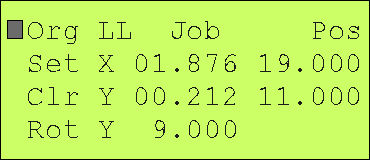 The buttons along
the right side of the panel, or along the top row of the handheld, marked
X,Y and Z may be used to select which Axis is to be jogged,
and what jog increment is to be used. Z is a special case for the
ssROUTER application which will bring up the
Work Surface
Menu. When for example the X button is hit, a blinking cursor
will appear over the inches digit of the X position display. Once
the X position has been selected, repeated hitting of the X Jog Button
will move the cursor through the tenths digit, hundredths digit, then the
thousandths digit, then back to the inches digit. While one
of these digits is highlighted by the blinking cursor, the UP and DOWN
keys may be used smoothly position the carriage or the ADJUSTMENT
Knob may be turned clockwise or counter clockwise to incrementally adjust.
Turning clockwise or hitting the UP key will increment the position by
the significance of the selected digit, and counter clockwise or the DOWN
key will decrement the position. The standard adjustment knob has
32 pulses per revolution. Any of the system axes may be adjusted
in the same manner. If either the UP or DOWN key is held down more
than 0.5 second, the key push will automatically put the jog into continuous
path motion at a smooth jog rate. Hitting either the ESC or ENTER
key will turn off the jog function and move the cursor over
to the SET selection in the Jog menu.
The buttons along
the right side of the panel, or along the top row of the handheld, marked
X,Y and Z may be used to select which Axis is to be jogged,
and what jog increment is to be used. Z is a special case for the
ssROUTER application which will bring up the
Work Surface
Menu. When for example the X button is hit, a blinking cursor
will appear over the inches digit of the X position display. Once
the X position has been selected, repeated hitting of the X Jog Button
will move the cursor through the tenths digit, hundredths digit, then the
thousandths digit, then back to the inches digit. While one
of these digits is highlighted by the blinking cursor, the UP and DOWN
keys may be used smoothly position the carriage or the ADJUSTMENT
Knob may be turned clockwise or counter clockwise to incrementally adjust.
Turning clockwise or hitting the UP key will increment the position by
the significance of the selected digit, and counter clockwise or the DOWN
key will decrement the position. The standard adjustment knob has
32 pulses per revolution. Any of the system axes may be adjusted
in the same manner. If either the UP or DOWN key is held down more
than 0.5 second, the key push will automatically put the jog into continuous
path motion at a smooth jog rate. Hitting either the ESC or ENTER
key will turn off the jog function and move the cursor over
to the SET selection in the Jog menu.
While in the JOG mode, the HOLD
key is still active. You can use it to rapidly move between the WORK
ZERO position, or the VIEW position. The STOP
key is also active. You can use it to HOME the system with a single
keypush. It may also be used for a quick way to set work zero on
systems that the spindle xy position may be easily positioned with the
motors off, such as a gantry system with rack and pinion drive. If
the STOP key is held down for a couple of seconds, the X and Y motors will
be temporairly turned off. The spindle may then be manually moved
to the work zero positiion. Click the ENTER key while the cursor
is at the SET position in the JOG menu. The system will then be homed,
but it will remember the position that you manually set the carriage to
and load that into the WORK ZERO POSITION.
After making adjustments to the motion system position
using the Jog function, the resulting position may be used to set
a new zero reference point for the Jobs being run using the SET selections.
The selection is made using the panel UP key or DOWN key to move
the blinking cursor to one of the four selections. If the ENTER key
is then hit, the selected function is executed. If the ESC
key is hit the jog menu is exited without any effect on work zeros.
1.3.1.1 ORG
For most applications data is output in a
standard cartesian coordinate system, with the LowerLeft corner
being x0,y0 and positive x increasing to the right and positive y increasing
to the top of the drawing. Drawings are normally done within a work
frame, with the lower left corner being x0,y0. The piece you are
going to route may be fixtured on the table at a different position.
Jogging the machine spindle to that point and selecting SET will set this
point as the new work zero. This is the normal and most common use of the
JOG function.
The Orgin function allows you to select either
the LL lower left which is normal, UL which is common for many windows
graphical programs such as Corel Draw, or one of two presets Preset1 or
Preset2. The presets may be set by the user for standard fixture
locations, or perhaps one for the center of the machine work area.
The preset settings are stored internally in Flash memory. When you
set or clear the presets, an Are-You-Sure menu pops up which you must respond
to in order to change these values to avoid accidental settings.
Each time click on ENTER while the cursor is positioned
in front of ORG, you will step to the next possible origin setting.
As a convenience, any time a new job is loaded, it will initialize
its job zero setting to be the same as the currently selected job.
If the work zero is subsequently changed, it is saved with the job
file so the job may be run again later without reseting the work zero.
1.3.1.2 SET WORK ZERO POSITION
If you click on this menu item, the current
xy position of the Spindles assembly is set as the x0,y0 reference point
for your job.
1.3.1.3 CLR WORK ZERO POSITION
If you click on this menu item, the current
work zero selection is cleared to it's default position..
1.3.1.4 ROT SET ROTARY SPINDLE ALIGNMENT
This allows you to position your Spindle over the centerline
of your rotary axis and save its position, so that when a rotary job is
done, the spindle will automatically align over the rotary fixture..
Back to Table of Contents
1.3.2 FEED BUTTON
Pushing the FEED button will cause the Operation
Display menu to be selected and the cursor to be moved to the feed rate
setting F on the bottom line. The feedrate may be adjusted using
the UP and DOWN keys or using the ADJUST knob. The feedrate setting
may be adjusted at any time, even while a job is running. The feedrate
change will not apply to the currently running vector if the Job is running.
If the feedrate has been originally set by software override from the ssROUTER
windows driver or the TestraMW CAD/CAM system, the adjustment of the feedrate
while the job is running will also be stored in the job file in the buffer,
so if the job is repeated it will use your adjusted feedrate.
1.3.3 SPEED BUTTON
Pushing the SPEED button will cause the Operation
Display menu to be selected and the cursor to be moved to the spindle speed
setting S on the bottom line. The speed may be adjusted using the
UP and DOWN keys or using the ADJUST knob.
The speed setting may be adjusted at any time, even while a job is running..
Speed changes will have an immediate effect if the spindle is turned on,
and it is software controllable. The adjustment of the speed while
the job is running will also be stored in the job file in the buffer at
the last speed command, so if the job is repeated it will use your adjusted
speed levels.
1.3.4 PLUNGE BUTTON
Pushing the PLUNGE button will cause the Operation
Display menu to be selected and the cursor to be moved to the plunge feed
rate setting P on the bottom line. The plunge feedrate may be adjusted
using the UP and DOWN keys or using the ADJUST knob. The plunge feedrate
setting may be adjusted at any time, even while a job is running.
The plunge feedrate change will not apply to the currently running plunge
vector. If the plunge feedrate has been originally set by software override
from the ssROUTER windows driver or the TestraMW CAD/CAM system, the adjustment
of the feedrate while the job is running will also be stored in the job
file in the buffer at the last plunge setting, so if the job is repeated
it will use your adjusted plunge feedrate.
1.4 WORK SURFACE
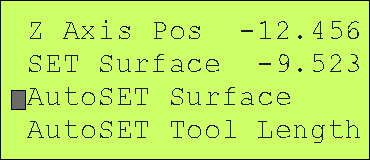 This menu may
only be entered while in the Jog mode by hitting the Z button on
the panel. When this menu is first entered, the cursor will be at
the tenths digit of the Z Axis position on the first line of the display
which shows the current Z-axis position.. Jogging control works the
same as any of the other axes. If the surface, which is the work z0 position,
is to be set manually by jogging, then position the the spindle over a
place where you can touch the tip of the tool to the work piece.
You can move between which axis you wish to adjust by hitting the appropriate
axis letter X,Y,Z or R. Once you have finished
making the adjustment, hit the ESC key. The Cursor will move in front
of SET Surface. The number to the right on this line is the the current
surface setting.
This menu may
only be entered while in the Jog mode by hitting the Z button on
the panel. When this menu is first entered, the cursor will be at
the tenths digit of the Z Axis position on the first line of the display
which shows the current Z-axis position.. Jogging control works the
same as any of the other axes. If the surface, which is the work z0 position,
is to be set manually by jogging, then position the the spindle over a
place where you can touch the tip of the tool to the work piece.
You can move between which axis you wish to adjust by hitting the appropriate
axis letter X,Y,Z or R. Once you have finished
making the adjustment, hit the ESC key. The Cursor will move in front
of SET Surface. The number to the right on this line is the the current
surface setting.
1.4.1 AUTOSET SURFACE
This feature will only work if it is enabled
in the AUTOSET parameters menu and the thickness
parameter for the TouchTop plate set properly. You also need
your TouchTop plate properly connected to the ss4544 motion control system.
Set your TouchTop plate on the work surface. It must be flat for this to
work properly. Jog the spindle so that the cutting tool is over the
TouchTop plate, then hit ESC. The cursor will automatically jump
in front of AutoSET Surface, then hit the ENTER key. The Z-axis will
then move down at its slow start speed until it hits the TouchTop plate
at which time it will stop.. The measured surface position will then
be automatically entered at the SET Surface position of the display, and
the Z-axis will retract back to the home position.
A home check will be done to check that the Z-axis
was not crashed during the proceedure. If correctly set one
of two events will take place.
1) If this is the first time the Job has been run,
i.e. you are starting a new job, and the AutoSET Tool Length feature has
been enabled then the spindle will move to the toolchange position and
the AutoSET Tool Length will be executed.
2) If the AutoSET Tool Length feature has not been
enabled, then the menu will automatically change back to the Operation
Display.
If the surface was not correctly set, the cursor
will move back to the Z Axis Pos at the tenths digit and be returned to
the Jog mode.
1.4.2 AUTOSET TOOL LENGTH
OFSET
This feature is available only if enabled in the
Auto
Tool Settings menu and the appropriate position constant has
been set.in that menu. When executed the spindle will be moved to the tool
change position if not already there. The Z-axis travel limit will
be increased to the Z-axis maximum travel. The Z-axis will then be
moved down at its slow start speed until the current tool touches the Tool
Touch Pad, or until the maximum travel is reached. If the maximum
travel is reached this would be an error condition, i.e. no tool or hardware
malfunction. After a touch occurs the system now knows the Z-axis travel
distance from the home position to the Tool Touch Pad. This distance
is added to the Touch Pad Offset to set the maximum Z travel distance.
The purpose for this is to avoid cutting into your table's work surface
should something be wrong with your job file or job setup. Next,
depending on the state of your job, one of two things will occur:
1) If this is the first time this feature
has been used after powering up the ss4544 system, then no other action
will be taken.
2) In all other cases the difference in length between
this tool and the last installed tool will be subtracted from the work
surface. This allows the operator to set a work surface with the
first tool when the job is started, and after that the operator only has
to change the tool when a tool change is called for.
2.0 MENU SYSTEM AND MAIN MENU
The menu system is controlled by the four buttons
on the panel highlighted in blue/green, UP, DOWN, ENTER, and ESC.
The ESC key is used to escape or back out of a menu or variable adjustment.
If the ESC key is hit repeatedly, you will eventually get to the top or
Main
menu then toggle betweenthe Operations Display and the Main menu.
The UP and DOWN keys are used to move the menu selection cursor around
the menu, and adjust variables up or down. The ADJUSTMENT knob
may also be used interchangeably with the UP and DOWN keys. The
ENTER key is used to select and cause execution of the menu item
indicated by the highlight or cursor.
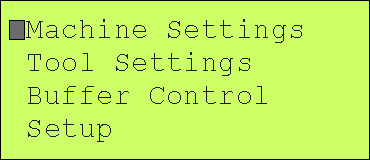 In the case of an adjustment of a number, pushing the ENTER key will move
the blinking cursor to the next digit to the right until the least significant
is reached, at which time the cursor will move to the most significant
digit. The ESC key will cause the adjustment to terminate, leaving
the edited number.
In the case of an adjustment of a number, pushing the ENTER key will move
the blinking cursor to the next digit to the right until the least significant
is reached, at which time the cursor will move to the most significant
digit. The ESC key will cause the adjustment to terminate, leaving
the edited number.
The Main Menu can be reached from any menu
by continually hitting the ESC key, which backs you up one menu level
for each push of the ESC key. From the Main Menu you can go to one
of the following menus:
MACHINE SETTINGS
TOOL SETTINGS
BUFFER CONTROL
SETUP
Back to Table of Contents
2.1 OPERATION DISPLAY
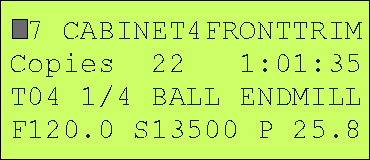 The OPERATION
menu is automatically selected on power up initialization of the
system. Otherwise it is accessed through the menu
system from the MAIN menu. Repeatedly hitting ESC will
always back you up through the menu tree and you will eventually
end up at the MAIN menu. When a job is running or paused and
the operation display has been selected, the display will be basically
as shown here. If the system is idle, the cursor will
be in the upper left corner of the display on the first line which is the
file selection. When in this state, you may select a
different file with the ADJUSTMENT knob or use the UP or DOWN keys .
The number on the line is the file number in the local buffer memory.
The name following is the job file descriptor. The jobfile descriptor
will only be there if the job file was created according to the Testra
HPGL interface specifications.
The OPERATION
menu is automatically selected on power up initialization of the
system. Otherwise it is accessed through the menu
system from the MAIN menu. Repeatedly hitting ESC will
always back you up through the menu tree and you will eventually
end up at the MAIN menu. When a job is running or paused and
the operation display has been selected, the display will be basically
as shown here. If the system is idle, the cursor will
be in the upper left corner of the display on the first line which is the
file selection. When in this state, you may select a
different file with the ADJUSTMENT knob or use the UP or DOWN keys .
The number on the line is the file number in the local buffer memory.
The name following is the job file descriptor. The jobfile descriptor
will only be there if the job file was created according to the Testra
HPGL interface specifications.
The next line shows the number of Copies
run of the current job followed by a time descriptor.
The first time a file is run, the time descriptor shows the
current elapsed time of the job as it is being run. During
any repeat of the job, the time descriptor will be counting down,
showing how much time remains to finish the job.
The final two lines of the display show the current
tool selection information. The third line shows the tool number
and its description. This tool descriptor will only appear if the job file
was created according to the Testra HPGL interface specification. The bottom
line has first the current FEEDRATE which is indicated by the letter F
followed by the feedrate in inches per minute. The second parameter
is the spindle speed indicated by the letter S followed by the speed in
revolutions per minute. The last item is the PLUNGE RATE which is indicated
by the letter P followed by the feedrate in inches per minute.
The FEEDRATE may be adjusted at any time by hitting the
FEED button. This will cause a blinking cursor to appear at the F
on the display. The feedrate may then be adjusted with the ADJUST
knob, or with the UP or DOWN keys. Hitting any other keys will take
you out of that function. In the same manner you may adjust the spindle
speed by hitting the SPEED button, or the plunge feedrate by hitting the
PLUNGE button.
Back to Table of Contents
2.2 MACHINE SETTINGS
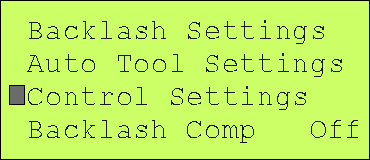 This menu
allow you to setup and adjust machine features that may be user preferences,
or particular to how the user has configured and fixtured his machine.
This menu
allow you to setup and adjust machine features that may be user preferences,
or particular to how the user has configured and fixtured his machine.
Back to Table of Contents
2.2.1 BACKLASH SETTINGS
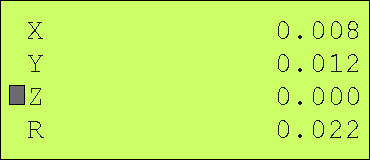 Here you
may enter backlash measurements for your specific machine. They will
only be used if backlash compensation is turned ON.
Here you
may enter backlash measurements for your specific machine. They will
only be used if backlash compensation is turned ON.
2.2.2 AUTO TOOL SETTINGS
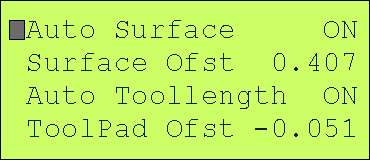 This menu
is used to set up automatic tool length compensation
and work surface detection features.
This menu
is used to set up automatic tool length compensation
and work surface detection features.
2.2.2.1 Auto Surface
This feature may be toggled ON or OFF.
2.2.2.2 Surface Ofset
This parameter must be set to the measured
thickness in inches of the TouchTOP pad used to detect the work surface.
2.2.2.3 Auto Tool Length
This feature may be toggled ON or OFF
2.2.2.4 Auto Tool Touch Pad Position
This parameter must be set to the measured distance
in inches between the top of the Tool Touch Pad and the work surface of
your machine or an imaginary plane slightly above the machine work surface.
The intent is to limit the possible travel of the tool tip so that you
cannot accidentally cut into your machine. The pad is mounted directly
below the tool change position on the machine. If the pad is below
the machine work surface plane, the number should be negative.
2.2.3 CONTROL SETTINGS
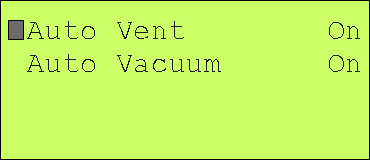 This menu
is used to select various output control options.
This menu
is used to select various output control options.
2.2.3.1 Auto Vent
Clicking on this selection will toggle the Auto
Vent option ON/OFF. When set ON, the VENT (Exhaust) output will switch
to +5V HIGH as soon as a Job is started, and will remain on until 10 seconds
after the Job is completed.
2.2.3.2 Auto Vacuum
Clicking on this selection will toggle the Auto
Vacuum holddown option ON/OFF. When set to ON the VACUUM (Gas) output
will be set to +5V HIGH as soon as a Job is started, and will immediately
turn off after the Job is completed. If the VACUUM has already been
manuall set ON, it will remain on until the Job is completed.
2.2.4 BACKLASH COMPENSATION
This menu selection allows you to toggle ON/OFF
backlash compensation. When backlash compensation is ON, whenever
an axis is going to reverse directions, the backlash amount for that axis
is either added in or taken out by adding a small motion vector.
The disadvantage of having the correction is that the job may take additional
time to run, particulairly on the Z axis when operating in 3D. The
advantage is improved accuracy.
Back to Table of Contents
2.3 TOOL SETTINGS
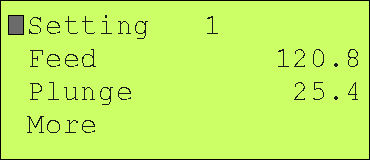 If you select Setting and hit ENTER, the cursor will move over to
just past the tool number where you can select one of the nine tool settings
or the SW (SoftWare) tool setting which is the default.. For each
selected tool you may adjust any of it's parameters. On this menu
you may only adjust Feedrate or Plunge for the pen. To adjust any
other parameters you will have to Click on MORE which
will bring up another continuation menu.
If you select Setting and hit ENTER, the cursor will move over to
just past the tool number where you can select one of the nine tool settings
or the SW (SoftWare) tool setting which is the default.. For each
selected tool you may adjust any of it's parameters. On this menu
you may only adjust Feedrate or Plunge for the pen. To adjust any
other parameters you will have to Click on MORE which
will bring up another continuation menu.
The SW setting is the default for job files without
any pen commands or speed and feed commands. With a file created
according to the Testra HPGL specification, tool setting information
is contained within the file and will be continually changing this parameter.
Manual changes from the panel will be reflected back into the file.
You can think of the SW settings as being temporary.
The numberd settings correspond to HPGL SPn; commands
where n is the setting or tool number. If these are in the job file,
the settings that you have saved here will be used for the job.
Back to Table of Contents
2.3.1 MORE
 This menu allows you to change the other tool parameters. The SPINDLE
parameter controls the spindle speed of programable spindles.
The COOLANT parameter controls the output signal on the panel or Automation
interface which may be used to turn on a valve for gas or other coolant
to cool the cutting tool.
This menu allows you to change the other tool parameters. The SPINDLE
parameter controls the spindle speed of programable spindles.
The COOLANT parameter controls the output signal on the panel or Automation
interface which may be used to turn on a valve for gas or other coolant
to cool the cutting tool.
Back to Table of Contents
2.4 BUFFER CONTROL
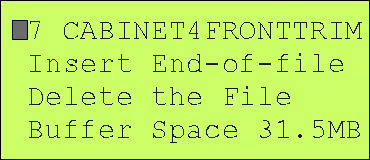 The Buffer control menu is used to manage the job data stored in the large
memory buffer. The last line of this menu shows the amount of buffer
space remaining for jobs. The cursor starts out on the first line
which shows the currently selected job in the buffer by its number
and description from the job file. If this is selected by pushing
the ENTER key, the UP and DOWN keys or ADJUST
knob may be used to scroll through the buffer to see what is in it.
Once the correct file has been located, hit the ESC key to get back
to the menu selections. To delete the job file, move the cursor
to Delete the File and press the ENTER key. This will take you to
another
Delete the File menu that asks if you
are sure giving you another chance if pushing the button was a mistake.
Once a file is deleted, you will have to reload it again from your computer
if you want to re-run the job. Also since the buffer memory is volatile
if power is turned off, all of the files will be lost.
The Buffer control menu is used to manage the job data stored in the large
memory buffer. The last line of this menu shows the amount of buffer
space remaining for jobs. The cursor starts out on the first line
which shows the currently selected job in the buffer by its number
and description from the job file. If this is selected by pushing
the ENTER key, the UP and DOWN keys or ADJUST
knob may be used to scroll through the buffer to see what is in it.
Once the correct file has been located, hit the ESC key to get back
to the menu selections. To delete the job file, move the cursor
to Delete the File and press the ENTER key. This will take you to
another
Delete the File menu that asks if you
are sure giving you another chance if pushing the button was a mistake.
Once a file is deleted, you will have to reload it again from your computer
if you want to re-run the job. Also since the buffer memory is volatile
if power is turned off, all of the files will be lost.
You can also delete all of the files by clearing
the buffer by moving the cursor to the line Buffer Space and hitting the
ENTER key. You will be taken to a Delete All
Files menu.
Back to Table of Content
2.4.1 INSERT END OF FILE
 Used to
manually insert an EOF mark in the buffer. This feature is necessary for
files that are sent to the ssROUTER application in the ss4544 that come
from programs not compatible with the ssROUTER printer driver or TestraMW
CAD/CAM software.
Used to
manually insert an EOF mark in the buffer. This feature is necessary for
files that are sent to the ssROUTER application in the ss4544 that come
from programs not compatible with the ssROUTER printer driver or TestraMW
CAD/CAM software.
Back to Table of Contents
2.4.2 DELETE THE FILE
 Used to delete
a job in the buffer.
Used to delete
a job in the buffer.
Back to Table of Contents
2.4.3 DELETE ALL FILES
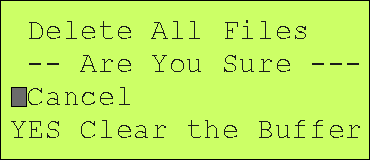 This menus
is used to confirm deletion of all of the current job files. This
will also reset the job numbers back to starting at one.
This menus
is used to confirm deletion of all of the current job files. This
will also reset the job numbers back to starting at one.
2.5 SETUP
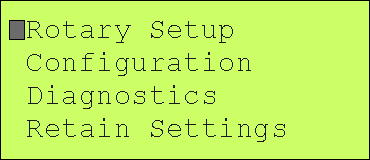 The
SETUP menu is used to access primarily maintenance functions and
would not normally be accessed by a machine operator. These functions
include the following menu items:
The
SETUP menu is used to access primarily maintenance functions and
would not normally be accessed by a machine operator. These functions
include the following menu items:
ROTARY SETUP
CONFIGURATION
DIAGNOSTICS
RETAIN SETTINGS
Back to Table of Contents
2.5.1 ROTARY SETUP
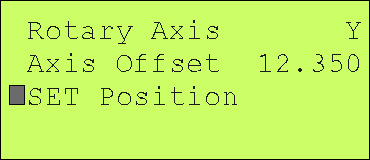 Adjustments
for a Rotary axis fixturing. This feature is not currently implemented
in the ssROUTER menusystem as of 1/15/3.
Adjustments
for a Rotary axis fixturing. This feature is not currently implemented
in the ssROUTER menusystem as of 1/15/3.
Back to Table of Contents
2.5.2 CONFIGURATION
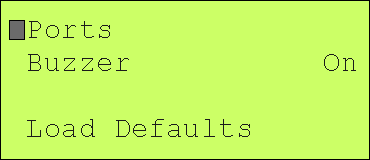 Load
Defaults restores initial setting parameters which weresetup in your
motion parameter set (MPM) when the machine was defined. This includes
initial backlash settings, baud rate etc.
Load
Defaults restores initial setting parameters which weresetup in your
motion parameter set (MPM) when the machine was defined. This includes
initial backlash settings, baud rate etc.
Back to Table of Contents
2.5.2.1 PORT SETTINGS
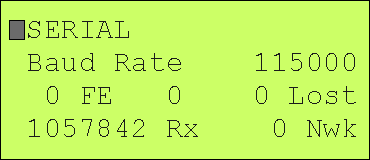 Here you
can change the Baud rate for communications between your PC which is sending
job files. Note that if you change here, you will also have to set
the baud rate for the port you are using in your PC to match.
Here you
can change the Baud rate for communications between your PC which is sending
job files. Note that if you change here, you will also have to set
the baud rate for the port you are using in your PC to match.
Back to Table of Contents
2.5.2.3 DEFAULTS
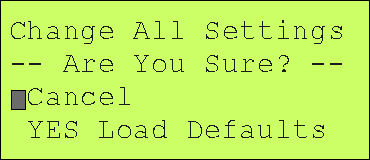 Used to
reload default parameter settings.
Used to
reload default parameter settings.
Back to Table of Contents
2.5.3 DIAGNOSTICS
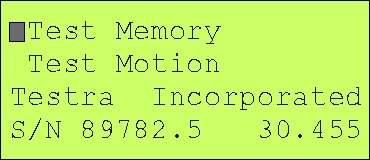
The Diagnostics menu allows you to test the buffer memory
in the ss4544 system that is used to buffer jobs downloaded from your PC
application or from the TestraMW CAD/CAM front end. The size of the
memory installed is shown in the bottom left corner of the menu.
To run the memory diagnostics, you will
first have to either terminate or let finish any job that is running.
The running of the memory test will destroy any jobs you have downloaded,
so they will have to be reloaded after the memory test is run. With
the cursor on line one in front of Memory Test push the ENTER key.
This will bring up the MEMORY test menu.
To run the Motion Test you will also have to terminate
or let finish any job that is running. Then move the cursor down
in front of the Motion test selection and press ENTER
Back to Table of Contents
2.5.3.1 MEMORY TEST
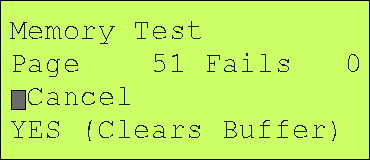 The memory test may be Canceled at any time by hitting the ENTER key while
the cursor is positioned in front of Cancel. Otherwise position the
cursor in front of Yes and hit the ENTER key. This will start up
the memory test. The memory test will run continuously until you
terminate the test by doing a Cancel. At that point you can leave
this menu by hitting ESC.
The memory test may be Canceled at any time by hitting the ENTER key while
the cursor is positioned in front of Cancel. Otherwise position the
cursor in front of Yes and hit the ENTER key. This will start up
the memory test. The memory test will run continuously until you
terminate the test by doing a Cancel. At that point you can leave
this menu by hitting ESC.
The memory is broken up into pages of 65535 bytes.
As each page is tested the page number displayed will be updated.
Any failures encountered will be added to the Fails counter.
Back to Table of Contents
2.5.3.2 MOTION TEST
 The motion tests may be controlled like any other job. The random
tests will run forever unless you pause by hitting the HOLD button, then
terminate by hitting the STOP button. This feature is not currently
implemented as of 1/15/3.
The motion tests may be controlled like any other job. The random
tests will run forever unless you pause by hitting the HOLD button, then
terminate by hitting the STOP button. This feature is not currently
implemented as of 1/15/3.
Back to Table of Contents
2.5.4 RETAIN SETTINGS
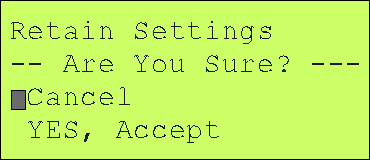 You may
either cancel or accept the settings. By accepting the settings,
any changes you may have made to machine parameters controlled by this
application will be saved to non volitile Flash memory. When the
system is powered down, and back up again the saved settings will be automatically
restored.
You may
either cancel or accept the settings. By accepting the settings,
any changes you may have made to machine parameters controlled by this
application will be saved to non volitile Flash memory. When the
system is powered down, and back up again the saved settings will be automatically
restored.
GO TO HOME PAGE
If you have comments or suggestions, email us
at support@testra.com
Testra Corporation 1201 N. Stadem Drive Tempe, AZ
85281 Ph. 480-560-6141 Fax: 480-907-2876
 SS4544 SyncroStep Motion Control System
SS4544 SyncroStep Motion Control System